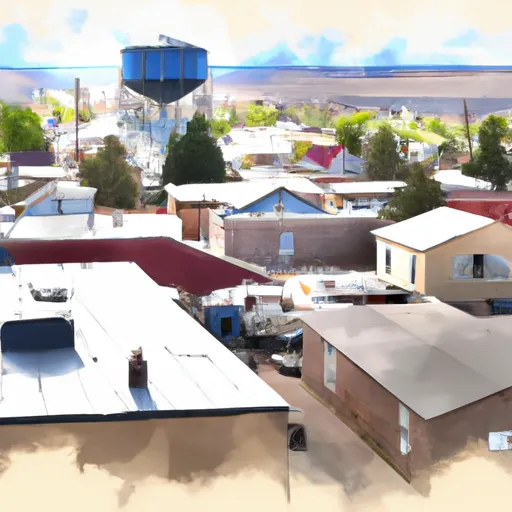-
 Snoflo Premium
Snoflo Premium
Get unlimited access to all our content
With no Ad interruptions! - Start Your Free Trial Login with existing account
Smoot
Eden Index
Climate
6.5
•
Recreation
3.5
•
Community
•
Safeguard
3.8/10

Smoot, Wyoming is a small unincorporated community located in Lincoln County. Situated in the western United States, Smoot experiences a semi-arid climate characterized by hot summers and cold winters. Summers are typically warm with temperatures reaching the mid-80s Fahrenheit, while winters are cold with temperatures dropping to the mid-20s. The area receives an average annual precipitation of around 12 inches, primarily in the form of snow during the winter months.
Hydrologically, Smoot is located near the Salt River, which flows through the region. The river serves as an important water source for irrigation and supports diverse aquatic life, making it an attractive spot for fishing enthusiasts.
Outdoor recreation opportunities abound in Smoot and its surrounding areas. The region is known for its breathtaking natural beauty and offers various activities such as hiking, camping, and wildlife viewing. The nearby Bridger-Teton National Forest provides countless trails for hiking and biking, while the Salt River Range offers opportunities for hunting and birdwatching. Additionally, the Salt River and its tributaries are popular for fishing, with a variety of trout species available.
Overall, Smoot, Wyoming offers a unique climate, diverse hydrology constituents, and a multitude of outdoor recreational activities, making it an ideal destination for nature lovers and outdoor enthusiasts.
What is the Eden Index?
The Snoflo Eden Index serves as a comprehensive rating system for regions, evaluating their desirability through a holistic assessment of climate health, outdoor recreation opportunities, and natural disaster risk, acknowledging the profound impact of these factors on livability and well-being.
Climate Health Indicator (CHI): 6.5
Smoot receives approximately
573mm of rain per year,
with humidity levels near 68%
and air temperatures averaging around
4°C.
Smoot has a plant hardyness factor of
4, meaning
plants and agriculture in this region thrive during a short period during spring and early summer. Most
plants will die off during the colder winter months.
By considering the ideal temperature range, reliable water supplies, clean air, and stable seasonal rain or snowpacks, the Climate Health Indicator (CHI) underscores the significance of a healthy climate as the foundation for quality living.
A healthy climate is paramount for ensuring a high quality of life and livability in a region, fostering both physical well-being and environmental harmony. This can be characterized by ideal temperatures, reliable access to water supplies, clean air, and consistent seasonal rain or snowpacks.
Weather Forecast
Streamflow Conditions
Snake Headwaters
Area Rivers
Snake Headwaters
Snowpack Depths
Snake Headwaters
Reservoir Storage Capacity
Snake Headwaters
Groundwater Levels
Recreational Opportunity Index (ROI): 3.5
The Recreational Opportunity Index (ROI) recognizes the value of outdoor recreational options, such as parks, hiking trails, camping sites, and fishing spots, while acknowledging that climate plays a pivotal role in ensuring the comfort and consistency of these experiences.
Access to outdoor recreational opportunities, encompassing activities such as parks, hiking, camping, and fishing, is crucial for overall well-being, and the climate plays a pivotal role in enabling and enhancing these experiences, ensuring that individuals can engage in nature-based activities comfortably and consistently.
Camping Areas
| Campground | Campsites | Reservations | Toilets | Showers | Elevation |
|---|---|---|---|---|---|
| Allred Flat | 32 | 6,779 ft | |||
| McCoy Creek | 17 | 5,692 ft | |||
| Hams Fork | 13 | 8,003 ft | |||
| Alpine | 16 | 5,687 ft | |||
| Lynx Creek | 10 | 6,195 ft | |||
| Moose Flat | 10 | 6,415 ft | |||
| Tincup | 5 | 5,847 ft | |||
| Lake Alice | 9 | 7,764 ft | |||
| Murphy Creek | 10 | 6,210 ft | |||
| Hobble Creek | 18 | 7,356 ft |
Nearby Fishing
Nearby Ski Areas
Catastrophe Safeguard Index (CSI):
The Catastrophe Safeguard Index (CSI) recognizes that natural disaster risk, encompassing floods, fires, hurricanes, and tornadoes, can drastically affect safety and the overall appeal of an area.
The level of natural disaster risk in a region significantly affects safety and the overall livability, with climate change amplifying these risks by potentially increasing the frequency and intensity of events like floods, fires, hurricanes, and tornadoes, thereby posing substantial challenges to community resilience and well-being.
Community Resilience Indicator (CRI):
The Community Resilience Indicator (CRI) recognizes that education, healthcare, and socioeconomics are crucial to the well-being of a region. The CRI acknowledges the profound impact of these elements on residents' overall quality of life. By evaluating educational resources, healthcare accessibility, and economic inclusivity, the index captures the essential aspects that contribute to a thriving community, fostering resident satisfaction, equity, and social cohesion.

